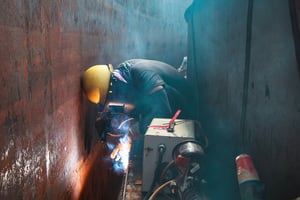
Workers encounter numerous hazards every day on the job. From selecting the proper PPE and emergency equipment, to being able to rely on devices that may save lives, preparation and readiness are the keys to minimizing risk.
Confined spaces are among the many hazards workers face daily.
Confined spaces are not designed for people, but workers may have to enter these areas regularly in order to perform maintenance tasks. These areas may have limited access, house unguarded machinery, have exposed wires, or lead to tapered areas that could limit proper air flow. Confined spaces may also contain hazardous material or gases that are extremely combustible, increasing the risk of gas explosions that are often catastrophic. Talk about having a very bad day!
Confined Spaces include:
- Vats
- Ditches
- Storage tanks
- Tunnels
- Underground electrical vaults
- Inside of Boilers
- Wells
- Cold Storage
- Culverts
How to Protect Workers in Confined Spaces
Gas detection devices are required by industry regulations and are critical to avoiding serious injury or death. Yes. Death. Gas detection devices help to identify gas leaks, potential threats, fire hazards or poisons, especially in confined spaces. Depending on the environment and working conditions, there are many different detectors ranging from portable and fixed units to multi-gas or single gas detectors.
Some great options are:
- GASCO Regulators: Regulators with gauges for use with various cylinder sizes. Demand flow regulator allows multiple analyzers to be tested on a single docking station and offered with multiple connections. Fixed flow regulators are piston sensed, nickel plated and a cost effective method of gas flow regulation.
- Gasco Multi-Component Calibration Gases: Useful as confined space entry as well as docking station users. Portable, take up minimal space and are easy to handle, these convenient calibration gas cylinders provide a cost-effective way to utilize calibration mixtures.
- Galaxy® GX2 Automated Test System: Easy to use, automated test stand provides simple, intelligent testing and calibration of gas detectors. This system enables total data access and control of the MSA ALTAIR family gas detector fleet.
Bump Testing is the daily testing of the functionality of gas detecting devices is required by ISEA. Harsh and rigorous conditions often lead to a breakdown in the effectiveness and reliability of a detector. The toxic gases in the environment can actually cause damage to the unit, making it extremely important to regularly monitor these devices. Other sensor failures may be due to a host of other problems including sensor ports becoming clogged or faulty battery life. When a worker’s life is on the line, the only way to be certain that gas monitors are functioning properly is by a daily bump test. When an explosion is a real possibility, don't take chances!
Bump Testing is best explained by OSHA to be qualitative function check in which a challenge gas is passed over the sensor(s) at a concentration and an exposure time sufficient to activate all alarm settings. Testing should be done daily before any job is performed. It is often overlooked but it really only takes a moment to do.
The main goals of bump testing are:
- To confirm that challenge gas is detected.
- To ensure that sensor reading will trigger alarm if challenge gas is detected.
- Avoid explosion and breathing in poison. (Kind of a big deal!)
Why is Calibration So Important?
You don't mess around with a loaded firearm without understanding how it works, do you? Well, when you are dealing with the potential for dangerous gases , you need to take the same precautions. Assessing risk and creating plans of action could be all the difference between workers sustaining life threatening injuries or going home to their families.
By taking a known concentration of a particular gas and exposing the device to it, you will be able to check the reading, note if the alarm functions and ensure that the device is keeping regular logs of activity. Because bump testing doesn’t test for accuracy, it is extremely important that the detector has also been properly calibrated. Calibration drift (unreliable readings) is very common due to the often volatile conditions of the site. Calibration is a critical part of maintenance and should be checked regularly to be certain that the instrument's measuring accuracy is relative to the traceable concentration of the test gas. Without this key step, it will be impossible to know exactly how much of a potential threat is in any given location.
Calibration systems are a great investment as they provide an easy, automated way to ensure gas detection devices are properly calibrated and functioning properly. From collecting information and logging important data to sending email alerts, these simple to use systems take the guesswork out of device calibration.
Just like checking your smoke detectors at home, properly testing and calibrating a facility’s gas detection device is crucial to the health and safety of workers, as well as protecting the facility itself. Especially in confined areas, it is important to verify proper sensor and alarm operation in order to know what hazards are present. Knowing potential hazards in the workplace can mean the difference between life and death.
Safety: It's Your Life, It's Our Business.








